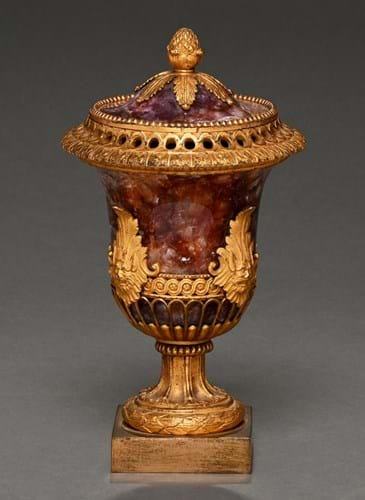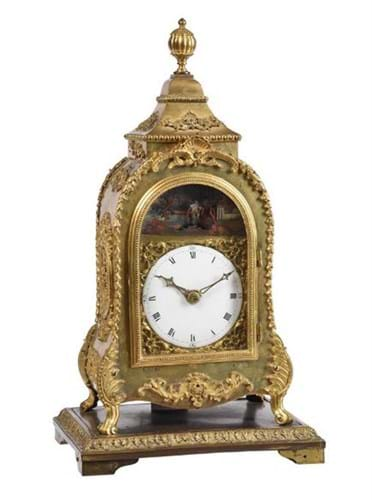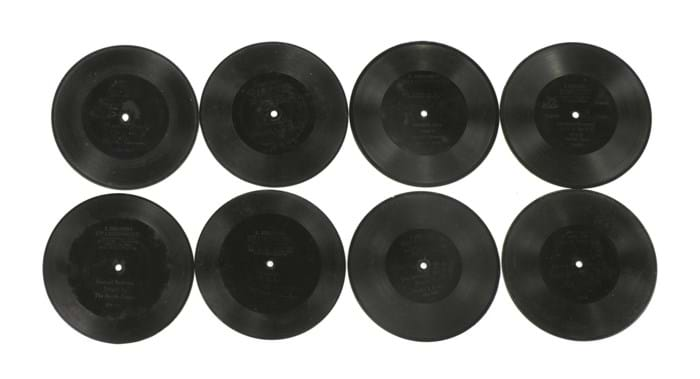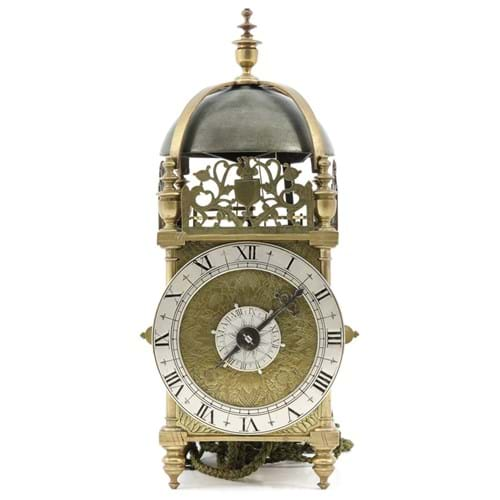1. Blue john perfume burner – £8000
In 1767 Josiah Wedgwood described the engineer and entrepreneur Matthew Boulton (1728-1809) as 'the most complete manufacturer in England in metal'.
At a cost of over £20,000, the Soho Manufactory in Birmingham had recently opened, complete with state-of-the-art machinery and a department for the large-scale production of ormolu. It was Boulton’s aim to emulate the French bronziers he had seen first-hand when visiting Paris in 1765.
Polished stone vases with mounts satisfying the Georgian craze for the ‘antique’ accounted for the majority of the firm’s ormolu production – the most popular made from the purple, blue and yellow fluorspar known as blue john. Such was their appeal that in 1768 Boulton himself attempted to purchase or lease the mines in Castleton, Derbyshire, to secure sufficient stock.
A number of variations on a ‘Roman’ theme are extant, most with reversible covers allowing the vases to function as either a candle sconce or as a cassolette for perfume or incense.
Three different forms were offered by Mellors & Kirk in Nottingham on March 8-9 including this campana shape vase known from the Boulton & Fothergill pattern book as 'Sphinx Vase Perfume Burner’. It stands 9in (23cm) high from square base to pineapple knop.
Dated to c.1770-82, these were originally supplied with the option of an additional lapis lazuli and ormolu Egyptian revival base cast to the four corners with a recumbent sphinx.
As detailed in Nicholas Goodison’s book Matthew Boulton: Ormolu (2002), Queen Charlotte bought a pair with bases for her private sitting room at Windsor Castle. Another single example took € 170,000 at a sale held by Mathias, Le Roux, Morel, Ribeyre in Paris in 2007.
Mellors & Kirk’s vase came for sale as part of a collection of Georgian and later blue john works of art. The body was in good condition although there was some loss and old repair to the cover.
Estimated at £5000-7000, it took £8000.
2. Anglo-Saxon gold shilling – £15,000
An Anglo-Saxon gold shilling or thrymsa dating from 650-70AD took £15,000 at Dix Noonan Webb in Mayfair on March 8. The coin, discovered by a metal detectorist in a stubble field near Haslingfield in Cambridgeshire in January this year, had been expected to fetch £8000-10,000.
The thrymsa was a gold coin minted from the 630s until the 670s originated as copies of Merovongian and earlier Roman coins. They had a value of four silver pennies, although continued debasement across this period reduced the gold content in newly minted coins to less than 35%.
The design for this coin, measuring just 13mm across and weighing 1.3 grams, is based on a Roman coin of the emperor Crispus from the 4th century. The legend includes Runic text which translated into Latin is Delaiona (‘of Laiona’) which may refer to the moneyer who struck the coin. Thrymsa were created at mints in Canterbury, London, and perhaps also Winchester.
Most coins from the series are known from hoards (the Crondall Hoard found in 1828 contained 100 similar gold thrymsa) although this is one of only eight examples of the ‘Crispus’ type recorded. It was also in extremely fine condition and centrally struck with all the inscriptions visible.
DNW said it was bought in the room by a member of the trade for a client.
3. ‘Uncorrected proof copy’ of Harry Potter – £20,000
With only an estimated 200 copies printed in 1997, the ‘uncorrected proof copy’ of Harry Potter and the Philosopher's Stone is a greater rarity than the first edition itself. Published by Bloomsbury in white and yellow wrappers, it famously includes a glaring error to title page – listing the author as ‘JA Rowling’.
This copy, in ‘very good condition with only very light handling’, is the third that Surrey auction house Ewbanks has offered in recent years. It came for sale on March 4 from a private individual in the publishing industry who has owned it since 1997. Guided at £8000-12,000, it took £20,000.
The auction house sold another copy in similar condition for £21,000 in May 2021 while in 2019 Sotheby’s took £22,000 for a ‘mint’ copy that included a proof sheet of the proposed illustrated dust jacket.
4. Chinese miniature table clock – £9000
Mechanical clocks were an important commodity with regards to maintaining healthy trade relations between London and the Chinese court in the 18th century. The emperor Kangxi (1662-1722) collected many western clocks (during his reign a Bureau of Chiming Clocks and a Bureau of Clockmaking were established) while his grandson Qianlong (1735-96) was known to own more than 2000 mechanical clocks – many of them still on display in the Forbidden City.
Such was the Qing interest in clockmaking that the imperial workshops were expanded to begin production in China. Helped by the technical know-how of Catholic missionaries, and the many English and continental European clocks available for comparison, there were more than 100 craftsmen employed to make clocks for the court.
Although very much in the European style, this 16in (40cm) gilt brass miniature table clock with a rocking figure automaton was probably made at the Guangzhuo workshops in the early to mid 19th century. At Dreweatts’ clocks sale in Newbury on March 2 it was expected to bring £3000-5000 but took £9000.
5. ‘Berliner’ gramophone discs – £5000
Emile Berliner (1851-1921), a German clerk in a Washington DC haberdashers, is credited with inventing both the first commercially successful disc record and the first machine to play it.
At a time when the wax cylinder phonograph was king, in November 1887 he was granted patents for a method of recording sound waves on a zinc disc, following soon after with the device he christened the ‘gramophone’. In time the grooved disc, that could be stamped out far more cheaply than Thomas Edison's phonograph cylinders, would became the basis of the recording industry.
A hand cranked ‘Berliner’ gramophone from c.1890-93 and numerous Berliner 7in discs formed part of the Russell Malcolm Barnes (1929-2021) collection offered at Sworders on March 1. Barnes worked at Bletchley Park and GCHQ and was involved in intelligence gathering but his true love was jazz. A proficient self-taught pianist, he was also a prolific collector of early jazz, blues, opera and music hall recordings and the mechanical devices upon which to play them.
Offered together, a group of more than 100 Berliner discs sold for £5000. In addition to a large variety of musical compositions are a rare disc from 1888 on which Emile Berliner reads the Lord’s Prayer and another produced by the Daily Mail newspaper to raise funds for soldiers wounded during the Boer War.
Barnes’ Kammer & Rheinhadt Berliner gramophone, with some replacement parts, sold at £2700.
6. Lantern clock by Peter Closon – €12,000
This lantern clock, offered for sale at Veilinghuis de Jager in Goes, Zeeland on March 1, brings together two important names in English horology. It is signed to the fretwork above the dial Peter Closon neare Holborne Bridge Fecit and has a provenance to George White, author of the first definitive work on lantern clock collecting – English Lantern Clocks (1989).
Although precious little is known of his life, Closon was among the most prolific of London lantern clockmakers. His work spans the period c.1620-60 (in 1630 he subscribed £5 to the incorporation of the Clockmakers’ Company). He is last mentioned in the Company’s records in October that year and is thought to have died around 1662.
This clock, with many typical Closon features (he used standard frames and fretwork), appears to be relatively early at around 1635-40. Quite possibly one of the several Closon clocks illustrated in White’s book, it was estimated at €3000-6000 but sold at €12,000 (£10,900).
A similar Holborne Bridge Fecit clock with early conversion to anchor escapement and long pendulum took $10,000 at Bonhams’ Art of Time sale in New York in 2018.











